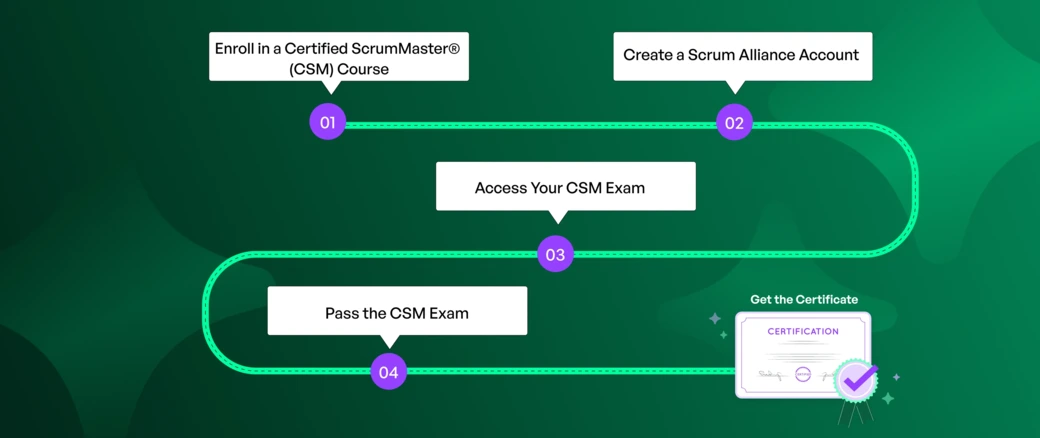 100% Money Back Guarantee
100% Money Back Guarantee




 CSM Training in Mumbai is delivered by Scrum Alliance’s Certified Scrum Trainers
CSM Training in Mumbai is delivered by Scrum Alliance’s Certified Scrum Trainers  This Scrum Master Certification in Mumbai includes 16 Scrum Alliance Authorised SEUs
This Scrum Master Certification in Mumbai includes 16 Scrum Alliance Authorised SEUs  A 100% Success Rate assured in this Scrum Master Training in Mumbai
A 100% Success Rate assured in this Scrum Master Training in Mumbai  Become CSM Certified in just 2 Days
Become CSM Certified in just 2 Days  Ace the CSM Exam in 2 Attempts or get a 100% Money Back
Ace the CSM Exam in 2 Attempts or get a 100% Money Back 
 2 Days Online Training
2 Days Online Training  Delivered by CSTs
Delivered by CSTs  16 PDUs and SEUs
16 PDUs and SEUs  Get Certification on 2nd Day
Get Certification on 2nd Day  Role plays, Games, & Simulations
Role plays, Games, & Simulations  Scrum Alliance Exam Fee Included
Scrum Alliance Exam Fee Included  2-year Membership with Scrum Alliance
2-year Membership with Scrum Alliance  100% Money Back Guarantee
100% Money Back Guarantee 
Learn the need for being agile in your software development projects. Understand the key concepts of the development using the agile approach which is driven by value. It is a well-organized project management process. Also, know how to embrace flexible planning methods. Become collaborative with the team, scrum master, and product owner.
a)Trivia About Agile Methodology
In order to correct issues cropping up due to the waterfall method, a new development practice was introduced in 2001 by a set of people called Agile Methodology. The main concept adapted in Agile is the iterative way. Set of software industry giants met in Snowbird, UT in 2000 to discuss this method. Then they decided to differentiate agile from the traditional method with some values and called them Agile Manifesto
b) Agile Framework – A Brief Overview
Agile's iterative software development method follows many frameworks including Scrum, Lean, Kanban, Extreme Programming, Feature-driven development etc. It is a big list and Scrum is the most commonly used framework. The scrum will focus on three roles to go through the development cycle: the scrum masters, developers and product owners.
c) Agile Manifesto
The set of values defined for Agile methodology is called Agile Manifesto. It was written in Feb 2001 by 17 independent software techies. There were several written among which 4 values were accepted by all which is given below.
d) Key Principles in Agile
The Agile Manifesto gave birth to 12 agile principles.
Learn about how the Scrum Master facilitates the Scrum Team and conditions where he doesn’t.
Yes, that’s how you can easily remember the five values of the scrum process. C FOR C means to Commit you to need Courage. To develop Courage you need to Focus With Open mind and Respect all in the team.
You got it right, it is Commitment – Focus – Openness – Respect – Courage
The framework of Scrum is simple and it deals efficiently with the changing situations. The work gets split into iterations. It is because during the development process the priority changes due to the situation, user mindset, technology etc. Therefore, the framework focuses on splitting the project into sequences of iterations called sprint. Every sprint will last for a maximum of 4 weeks. Therefore the complexity of the project is split and all changes are accommodated during the sprint meeting. There is not much of a loss and also the user gets the output per the expectation.
The framework is simply understood as Planning – Executing – Learning – Taking Actions. This will continue until the end result is achieved. Every sprint meeting will be in length to plan from the education of the previous sprint.
Scrum meetings happen when the scrum master, product owner, and development team meet to discuss the goals and the procedure to implement the same. There are many aspects of scrum meetings including:
Scrum artifacts are basically the set of information that the scrum team uses to make future decisions and set their goals. These details help in discussing how the product is developed, actions to produce it and actions performed during the projects. It includes the following elements:
Covering basic requirements to crack certification.
 1 Mock Exam
1 Mock Exam  100% Money Back Guarantee
100% Money Back Guarantee  Join WhatsApp Group for Support
Join WhatsApp Group for Support  Delivered by CSTS
Delivered by CSTS  2 Years Membership with Scrum Alliance
2 Years Membership with Scrum Alliance  Get 16 PDUs and SEUS
Get 16 PDUs and SEUS  Unlimited Revision Sessions
Unlimited Revision Sessions  JIRA and ACP Training and Certification
JIRA and ACP Training and Certification  100 Frequently Asked Interview Questions
100 Frequently Asked Interview Questions  Get 10+ Sample Resumes
Get 10+ Sample Resumes Get ready to crack certification with advanced preparation
 5 Mock Exams
5 Mock Exams  100% Money Back Guarantee
100% Money Back Guarantee  Join WhatsApp Group for Support
Join WhatsApp Group for Support  Delivered by CSTS
Delivered by CSTS  2 Years Membership with Scrum Alliance
2 Years Membership with Scrum Alliance  Get 16 PDUs and SEUS
Get 16 PDUs and SEUS  Unlimited Revision Sessions
Unlimited Revision Sessions  JIRA and ACP Training and Certification
JIRA and ACP Training and Certification  100 Frequently Asked Interview Questions
100 Frequently Asked Interview Questions  Get 10+ Sample Resumes
Get 10+ Sample Resumes The work force is your asset. Up-Skill them with our Corporate Training Programs!
 Unleash In-Demand Skills Across the Enterprise
Unleash In-Demand Skills Across the Enterprise  Align Skill Development with Business Objectives
Align Skill Development with Business Objectives  Drive Increased Employee Productivity
Drive Increased Employee Productivity  Leverage Immersive Learning
Leverage Immersive Learning 



The Scrum team deals with non-functional requirements by including them in the Product Backlog. During Sprint Planning, they prioritize these non-functional requirements along with functional ones. The team ensures that non-functional requirements are met by incorporating them into the Definition of Done and reviewing their approach during Sprint Retrospectives.
For each sprint, scrum teams plan work to be performed within sprints, should prioritize Product Backlog items that support the goal and establish a clear Sprint Goal. The team discusses and estimates the amount of work that needs to be done, then plans how to get there during the Sprint Planning meeting. Adjustments and constant communication are essential to adjusting to any changes that may arise during the Sprint.
With an emphasis on teamwork and continual improvement, a scrum master supports scrum processes and helps teams adhere to scrum ideals. On the other hand, a PMP (Project Management Professional) plans, manages, and closes projects using conventional project management techniques, with an emphasis on project scope, time, and cost control.
Non Tech courses provided by StarAgile
Tech courses provided by StarAgile





























































